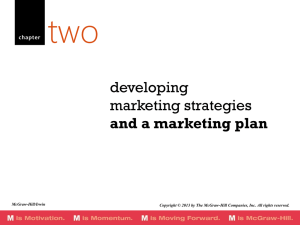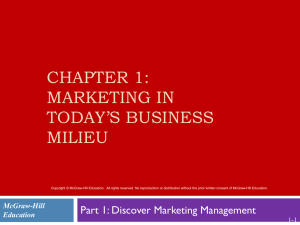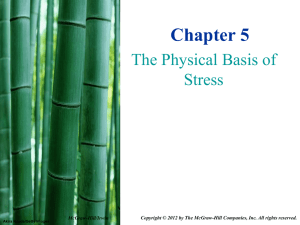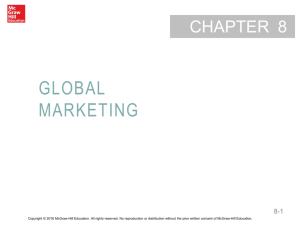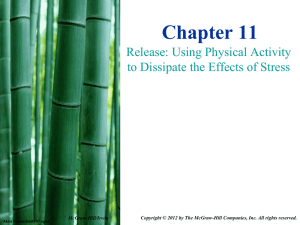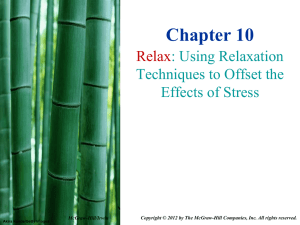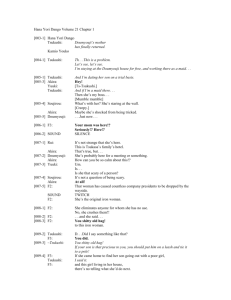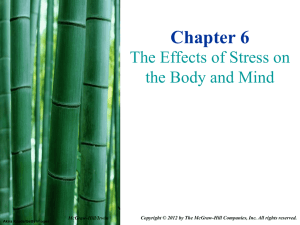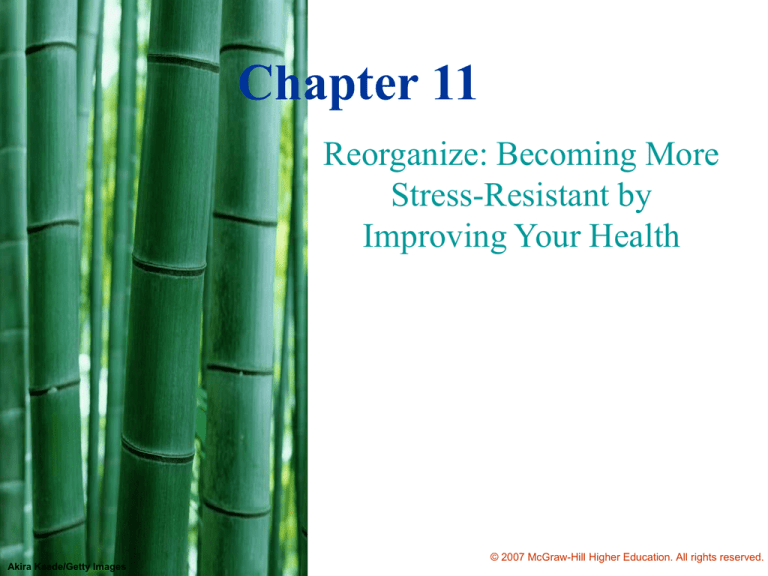
Chapter 11
Reorganize: Becoming More
Stress-Resistant by
Improving Your Health
© 2007 McGraw-Hill Higher Education. All rights reserved.
Akira Kaede/Getty Images
Overview
This chapter
Introduces the fifth and final of the Five
Rs of Coping—Reorganize—and
explains how a lifestyle-based approach
to coping with stress combines the use
of all five lines of defense against stress
and also both problem-focused and
emotion-focused approaches across six
dimensions of health and wellness
Discusses how using the hardy health
habits and the five strategies together
complement each other synergistically
© 2007 McGraw-Hill Higher Education. All rights reserved.
Akira Kaede/Getty Images
Outline
The importance of a
lifestyle-based approach to
coping that intentionally
moves us toward optimal
functioning in six health
and wellness dimensions
© 2007 McGraw-Hill Higher Education. All rights reserved.
Akira Kaede/Getty Images
Outline (Cont’d)
The six health and wellness
dimensions:
the environmental/occupational
dimension
the social dimension
the spiritual dimension
the intellectual dimension
the emotional dimension
the physical dimension
© 2007 McGraw-Hill Higher Education. All rights reserved.
Akira Kaede/Getty Images
Outline (Cont’d)
Using a strategy-based two-pronged
approach to reorganizing each
dimension of health and wellness:
Problem-focused
Emotion-focused
Move toward optimal functioning by
linking hardy health practices and the
Five Rs of Coping strategies together
and practicing them on a daily basis
© 2007 McGraw-Hill Higher Education. All rights reserved.
Akira Kaede/Getty Images
Outline (Cont’d)
This creates a synergistic effect
against stress (and toward
wellness and coping)
© 2007 McGraw-Hill Higher Education. All rights reserved.
Akira Kaede/Getty Images
A Lifestyle-Based Approach to
Coping
Stress does not occur in a vacuum
Stress has as much to do with our
general level of functioning as it
does with the stressor itself
When we are functioning
inefficiently, we have fewer
resources to help us manage stress
Move toward optimal functioning
Move toward high-level health
and stress management
© 2007 McGraw-Hill Higher Education. All rights reserved.
Akira Kaede/Getty Images
Reorganizing
To reorganize is to take a lifestyle-based
approach to coping with stress
It is stressor preventive in nature
It is aimed at improving your overall
health level to be more stress-resistant
Kobassa et al. found that hardy people use
hardy health practices such as
regular exercise
good nutrition
relaxation
© 2007 McGraw-Hill Higher Education. All rights reserved.
Akira Kaede/Getty Images
Moving Toward Optimal
Functioning
The journey (process) of moving toward
optimal functioning is as important as
the results you achieve
During any given stress transaction, your
ability to appraise a potential stressor is
influenced by your general level of
wellness across all six dimensions of
health
Be patient and self-forgiving in this
journey
© 2007 McGraw-Hill Higher Education. All rights reserved.
Akira Kaede/Getty Images
A Two-Pronged Model for
Reorganizing Our Health
Reorganizing is done in response to some
perceived lifestyle shortcoming
Sometimes it’s best to approach the
deficiency head on (be problem-focused)
Other times, when we can’t change the
situation (at least right now), an emotionfocused approach helps us reorganize our
thoughts
© 2007 McGraw-Hill Higher Education. All rights reserved.
Akira Kaede/Getty Images
Reorganizing the Environmental
Dimension of Health
Strengthen the micro environment (our
immediate environment: home, work place,
community, campus)
Strengthen the macro environment (the
world at large, the global community)
Being proactive and taking concrete steps to
reorganize aspects of your environment helps
you assume some degree of control over your
life
© 2007 McGraw-Hill Higher Education. All rights reserved.
Akira Kaede/Getty Images
A Problem-Focused Approach to
Reorganizing the Micro Environment
Many problem-focused approaches
to coping involve altering one’s
environment
Employ both short- and long-term
reorganizing strategies to change
environmentally-based stressors
© 2007 McGraw-Hill Higher Education. All rights reserved.
Akira Kaede/Getty Images
An Emotion-Focused Approach to
Coping With the Macro
Environment
A common macro environmental stressor:
terrorism
If the threat of terrorism becomes chronic,
defuse it by changing your illogical
thoughts and co-existing with the emotions
associated with them
Use Ellis & Harper’s ABCDE technique
© 2007 McGraw-Hill Higher Education. All rights reserved.
Akira Kaede/Getty Images
An Emotion-Focused Approach to
Coping With the Macro
Environment (Cont’d)
Use Morita Therapy to re-direct
your attention to productive work
Co-exist with strong feelings by
reminding yourself that they will
dissipate with time
© 2007 McGraw-Hill Higher Education. All rights reserved.
Akira Kaede/Getty Images
Reorganizing the Occupational
Dimension of Health
Most Americans who work full-time spend
close to 50 hours a week at their worksites
Reorganizing the occupational dimension
has two aspects
Improving the physical work environment
Improving your communications with
bosses, coworkers, and associates
The first step: assessing areas that can be
strengthened
© 2007 McGraw-Hill Higher Education. All rights reserved.
Akira Kaede/Getty Images
A Problem-Focused Approach to
Reorganizing the Occupational
Environment
To improve the physical work environment:
Be proactive in monitoring compliance with
NIOSH health and safety standards
Consider working through an employee union if there
is one
Contact NIOSH directly to report suspected violations
Use protective devices (e.g., noise/glare
reducers)
Suggest products that conform to ergonomic
guidelines
© 2007 McGraw-Hill Higher Education. All rights reserved.
Akira Kaede/Getty Images
A Problem-Focused Approach to
Reorganizing the Occupational
Environment (Cont’d)
To improve your communications with
bosses, coworkers, and associates:
Take responsibility for expressing your
concerns or clearing up
misunderstandings before they escalate
into stressors
Use “I” language and verbal assertiveness
techniques consisitently.
© 2007 McGraw-Hill Higher Education. All rights reserved.
Akira Kaede/Getty Images
An Emotion-Focused Approach to
Reorganizing the Occupational
Environment
When you are not able to change work place
situations or relationships now or in the
immediate future, understand and co-exist with
the emotions associated with them by assessing
how important they are in relation to the
bigger picture of your life
how they mesh with what you value, your life
purposes, and your daily life criteria for
happiness
whether they are even worth reorganizing
Use Ellis & Harper’s ABCDE Model to
reorganize
© 2007 McGraw-Hill Higher Education. All rights reserved.
Akira Kaede/Getty Images
Reorganizing the Social Dimension
of Health
Social relationships provide connections
to other people that add richness and
depth to our lives
It is in relationships with others that we
most fully develop our potential as
people
Social support networks help us cope
with unanticipated problems and
prevent potential stressors from
becoming actual stressors
© 2007 McGraw-Hill Higher Education. All rights reserved.
Akira Kaede/Getty Images
A Problem-Focused Approach to
Reorganizing the Social Dimension
Evaluate your social networks and
support
Take steps to shore up any
weaknesses
Build on the strengths that already
exist
© 2007 McGraw-Hill Higher Education. All rights reserved.
Akira Kaede/Getty Images
An Emotion-Focused Approach to
Reorganizing the Social Dimension
Our social support network can also be a
source of stress
Social embeddedness and support require
an investment of time and energy
The same people and groups who support
us often stir up strong emotions within us
Once again, assess what is really important
in your life
© 2007 McGraw-Hill Higher Education. All rights reserved.
Akira Kaede/Getty Images
Strengthening the Spiritual
Dimension of Health
Spirituality: a sense of
interconnectedness with something
beyond the self
It is not unusual for people to feel both
a belief in a divine power and a sense
of interconnectedness with other
living things, nature, etc.
© 2007 McGraw-Hill Higher Education. All rights reserved.
Akira Kaede/Getty Images
A Problem-Focused Approach to
Reorganizing the Spiritual
Dimension
If you have lost faith in life and your
fellow humans, one way to cope with
this and at the same time strengthen
your spiritual well-being is to take
action
Use your faith community’s outreach
programs to serve others (a way to coexist with troubling doubts and
emotions while engaging in productive
work)
© 2007 McGraw-Hill Higher Education. All rights reserved.
Akira Kaede/Getty Images
An Emotion-Focused Approach to
Reorganizing the Spiritual
Dimension
Naikan self-reflection (though not a
spiritual activity per se) is an excellent
way to help you become aware of your
interconnectedness to others in your life
It can help you become more grateful
for the role they’ve played in your life
Naikan’s three questions can shed light
on troubling thoughts and emotions
about people in your life to help defuse
them as stressors
© 2007 McGraw-Hill Higher Education. All rights reserved.
Akira Kaede/Getty Images
Reorganizing the Intellectual
Dimension of Health
The ability to separate fact from
fiction depends on our knowledge
Develop a commitment to thinking
clearly and using reason and logic
to guide you
Become a life-long learner
© 2007 McGraw-Hill Higher Education. All rights reserved.
Akira Kaede/Getty Images
A Problem-Focused Approach to
Strengthening the Intellectual
Dimension
Keep up with the literature in your area of
interest
Join and take an active role in professional
organizations related to your discipline or
area of interest
Joining committees and holding
organizational positions provides another
form of hands-on learning and networking
Apply what you’ve learned in the classroom
to real-world situations
© 2007 McGraw-Hill Higher Education. All rights reserved.
Akira Kaede/Getty Images
An Emotion-Focused Approach to
Strengthening the Intellectual
Dimension
Make the transition from being a
passive recipient of knowledge to an
active seeker of it on a lifelong basis
Use continuing education programs to
learn more about things that appeal to
you
Retain your intellectual curiosity—it can
help you maintain a vibrancy that can
stay with you throughout your adult and
older adult years
© 2007 McGraw-Hill Higher Education. All rights reserved.
Akira Kaede/Getty Images
Reorganizing the Emotional
Dimension of Health
Involves becoming more emotionally hardy
(developing emotional toughness)
Mental toughness: learning how to co-exist
with troubling emotions while being
productive
Moritists argue that understanding the origin
of our emotions isn’t necessary for learning
how to co-exist with them
Twin goals:
Become more mindful of your emotions
Learn how to co-exist with them
© 2007 McGraw-Hill Higher Education. All rights reserved.
Akira Kaede/Getty Images
A Problem-Focused Approach to
Strengthening the Emotional
Dimension
Become more mindful of anxious feelings
when they arise
Accept these feelings
Tell yourself that you can co-exist with them
and still be productive
Be completely prepared for a task that makes
you feel anxious
Use simple relaxation techniques before
beginning the task
Remind yourself that you can do the task
despite being anxious
© 2007 McGraw-Hill Higher Education. All rights reserved.
Akira Kaede/Getty Images
An Emotion-Focused Approach to
Strengthening the Emotional
Dimension
Trying to eliminate or reduce troubling emotions
Base this on the premise that you can modify or
eliminate troubling emotions by dealing with the
thoughts that they revolve around
By learning to think more logically about a
stressor, you reduce the likelihood that troubling
emotions associated with it will arise in the first
place
© 2007 McGraw-Hill Higher Education. All rights reserved.
Akira Kaede/Getty Images
An Emotion-Focused Approach to
Strengthening the Emotional
Dimension (Cont’d)
Use Ellis & Harper’s ABCDE Model
Key to emotion-focused approaches to improving
emotional well-being are
using them consistently
keeping reminding yourself that it is normal to
experience troubling emotions
becoming more mindful of them
accepting them as setting the stage for being able
to co-exist with the troubling emotions and
doing what needs to be done
© 2007 McGraw-Hill Higher Education. All rights reserved.
Akira Kaede/Getty Images
Reorganizing the Physical
Dimension of Health
Realize that many of the benefits of physical
activity, exercise, and fitness take a couple
of months to take effect
Make physical activity, exercise, and healthy
eating part of your daily lifestyle
Understand that making physical activity,
exercise, and healthy eating part of one’s
daily lifestyle is easier for some than for
others
© 2007 McGraw-Hill Higher Education. All rights reserved.
Akira Kaede/Getty Images
A Problem-Focused Approach to
Strengthening the Physical
Dimension
Have a plan for at least one indoor
and one outdoor physical activity
for each season
Identify activities that are fun (or
potentially fun)
© 2007 McGraw-Hill Higher Education. All rights reserved.
Akira Kaede/Getty Images
An Emotion-Focused Approach to
Strengthening the Physical
Dimension
Negative emotions about physical activity,
exercise, and healthy eating often contribute to
their discontinuance
Activity and eating patterns are among the
hardest habits to change
Often attempts to change are accompanied by a
pessimistic or cynical attitude
Use Seligman’s ABCDE Model when you find
yourself lapsing
© 2007 McGraw-Hill Higher Education. All rights reserved.
Akira Kaede/Getty Images
Wellness and Coping
To start controlling your stress, use the
Five Rs of Coping to improve your
level of functioning across all six
dimensions of health and wellness
A commitment to wellness and stress
management means a commitment of
time and energy to a chosen lifestyle
Make wellness and stress management
core values
© 2007 McGraw-Hill Higher Education. All rights reserved.
Akira Kaede/Getty Images
Chapter 11: Reorganize:
Becoming More Stress-Resistant
by Improving Your Health
Summary
© 2007 McGraw-Hill Higher Education. All rights reserved.
Akira Kaede/Getty Images


